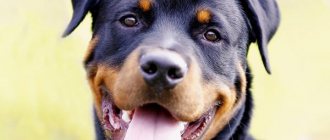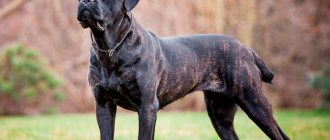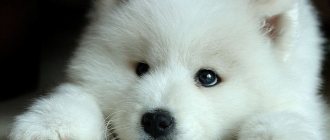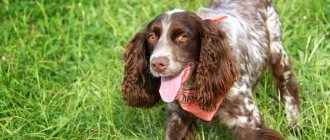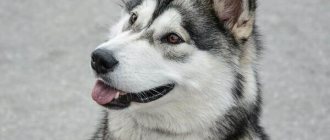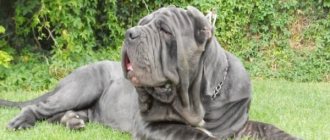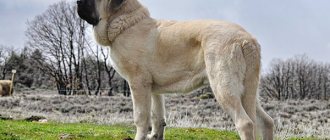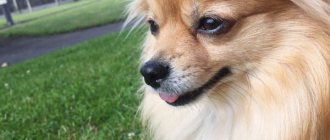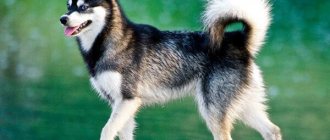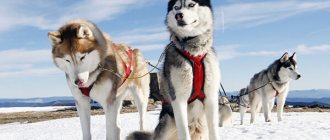There are no bad dog breeds - there are breeds that are not suitable for you. This is the main thing you need to learn before you start choosing a puppy. In order to understand who might be right for you, you should make a list of the breeds you like and study the characteristics of each of them. I’ll tell you about the miniature schnauzer - the breed that I chose, although it wasn’t even on the original list. Without concealment, I will name its advantages and disadvantages, advantages and disadvantages.
A miniature schnauzer named Chester is my first dog, and I am very glad that I chose this breed. After all, the wrong breed can discourage you from having dogs for the rest of your life. And I could do it, because... At first I liked completely different ones. I wanted a shepherd dog, a St. Bernard, a basset hound, a chow chow, a husky, a beagle, a Doberman and other big and not so big, sometimes simple, sometimes too complex dogs. After reading their descriptions, I realized that in terms of content and character they were not suitable for me. Sheepdogs and St. Bernards are too large and often shed heavily and also smell like dog. Chow Chows are stubborn and not as trainable as I would like. Huskies and Dobermans are stubborn and dominant, but I didn’t want to live and strain myself, posing as an alpha female: I don’t like that, I’m more suited to animals that I can love and not think that because of this they might respect me less and disobey.
Article continues after advertisement
In general, I found incriminating evidence for all the breeds that I liked, after which I didn’t want to get involved with them. I'm not trying to say they are bad. They just didn’t suit me specifically, or didn’t fit the conditions that I’m ready to offer them: a city apartment, my husband and I are moderately active, the desire to travel with the dog around the world, the reluctance to smell the strong smell of a dog and endlessly remove the hair that falls out. Adding to all the difficulties was the presence of a cat, i.e. it was necessary to take a breed that is friendly towards cats and does not cause damage to them during games.
In addition, the dog had a number of requirements: sociability, kindness, courage, stable psyche, positivity, good trainability. And I found such a breed - these are schnauzers, in particular, miniature schnauzers.
Well, now I’ll tell you about all their advantages and disadvantages in order. I will do this using my dog as an example - it seems to me that he is a bright and typical representative of a good breed type in all criteria: appearance, intelligence, psyche.
Description and characteristics
The Miniature Schnauzer is a working and hunting dog.
The dog is “universal” - he performs “service”, protects the territory, and tracks down game. Stocky build, well-developed muscles. The head is large with a wide forehead. Eyebrows, mustache, and beard are prominent. The jaw is powerful. Small dark oval eyes. The neck is muscular, the back is slightly sloping, the chest is arched. Paws are shortened, with strong claws. Cropped ears are erect; undocked ears are of medium length and rise in the middle. The tail is set high and usually docked short. The color can be gray, black, white.
The Zwerg is the smallest of the Schnauzers. Height - no more than 35 cm, weight - no more than 7 kg. A male dog does not differ in size from a female dog.
Take the Attention Test! Find 10 differences! (click right here!)
Find the answer Are you bothered by some problem or question? Enter “Breed” or “Name of the problem” into the form, press Enter and you will find out everything about the issue that interests you.
Types of colors
There are several types of colors in the Miniature Schnauzer dog breed. Photos and descriptions of colors can be divided into 4 groups, which are accepted by everyone as generally accepted varieties of colors. And there is another one, not accepted by the international canine organization.
- Black color. Here, in principle, it is obvious: the dogs are completely black with black undercoat.
- Pepper and salt. This coloration indicates the presence of many shades of gray or metallic color with lighter tones. The undercoat is gray.
- Black color with silver (grayish areas).
- Completely white with a whitish undercoat.
- The chocolate and tan color is very controversial, as it is not recognized by the cynological organization. However, you can often find dogs with this color.
Only pepper and salt and black colors were recognized for a long time until 1976, until black and silver were recognized, and then white coloring in 1992.
Positive traits
The following advantages of a miniature schnauzer are highlighted:
- Security quality;
- The wool does not shed;
- Loyalty;
- Innate intelligence;
- Trainable;
- Possibility of living in an apartment.
Guard qualities are innate. The little puppy is already showing wariness, does not trust strangers, and is trying to protect its owner. Kids act bravely in the face of danger. Miniatures do not trust strangers. They will growl or bark as a warning; sensing danger, they are capable of biting. He responds to aggression instantly.
The fur does not shed. There will be no dog hair in the house or on clothes. The pet needs to be combed to remove dead hair.
Miniatures are devoted to their owner and members of his family. They get along well with children; the child will find a loyal friend for fun in the dog.
Has natural intelligence. Understands intonation, gestures, and the owner’s gaze. He quickly gets used to his nickname and understands commands.
Training should start at an early age. Up to six months the dog is easy to train. Without training, the dog will be hysterical, capable of causeless aggression towards people and other animals. Reputation matters; the owner must show leadership towards the animal. Otherwise, the pet will not obey the owner and other family members.
Suitable for apartment maintenance. A compact-sized animal will not interfere in a small space. Zverg needs long walks. If your pet defecates in the litter box, this does not negate daily walks.
Dog training
Miniature Schnauzers are trainable and smart, so there shouldn't be any problems. You should train the dog yourself or send it to a training course.
Sometimes miniature dogs can be disobedient, which is also very desirable to correct as the pet grows older.
Training includes not only knowledge of commands, but also skills such as getting used to bathing, cutting hair, and wearing a leash. The ideal age for learning basic commands is up to 6 months. Such dogs are suitable for very active recreation, which must be taken into account when training.
Know: training is important, otherwise, due to its playfulness and mobility, the pet may begin to cause mischief.
Negative qualities
The disadvantage of the breed is:
- Necessity of trimming;
- Excess activity;
- Craving for leadership;
- Needs for long walks.
The coat must be kept in good condition, otherwise the miniature will look like a mongrel. Trim the hair yourself or go to a dog groomer.
The breed is energetic and active, so the Miniature Schnutzer is not suitable for stay-at-home owners and older people. The dog is tireless, tolerates long hikes, traveling in a car, and going into nature well. Requires similar activity from the owner.
Thoroughbred individuals are capricious and love to lead. If you constantly please the dog, he will consider himself in charge, and behavior problems will begin. An animal cannot be pampered; it must be treated with strictness, but not cruelty. From puppyhood, get used to the feeding regime and commands.
The walk should last at least 2 hours. Otherwise, the dog will waste energy creating disgrace in the house - it will run, bark, damage furniture, and mark corners.
https://dog-care.ru/porody/reyting/tsvergshnautser-otzyvy-vladeltsev.html
Miniature Schnauzer for active and attentive owners. Behavioral deficiencies often arise due to lack of training. With appropriate training and care, the breed demonstrates the best characteristics.
Health
Miniatures live on average 12-15 years. If the miniature schnauzer is properly cared for, the dog will be active until a very old age. Representatives of the breed are prone to the following diseases:
- Food allergies;
- Atopic dermatitis;
- The presence of comedones on the back;
- Cataracts that appear at any age. In severe cases, glaucoma develops;
- Retinal degeneration (occurs as you get older). The dog may become partially or completely blind;
Blindness in a Miniature Schnauzer
- Urolithiasis disease. More often occurs due to the consumption of low-quality food and heredity;
- Pulmonary artery stenosis. Genetic pathology;
- Heart rhythm disturbances;
- Hypothyroidism. Hormone deficiency, malfunction of the thyroid gland;
- Diabetes. Similar to hypothyroidism, it provokes disorders in the thyroid gland;
- Damage to the pancreas;
- Lipoma. Tumor in adipose tissue;
- Oncological diseases;
Unfortunately, it is impossible to predict the development of cancer in a puppy in advance.
- Malignant tumor in the testicles. More often observed in unneutered dogs;
- Epilepsy. It makes itself felt at 4-5 years. The attacks are spontaneous. You can read about the symptoms of primary and secondary epilepsy in dogs on our portal;
- Cryptorchidism. An anomaly characterized by non-descent of the testicle into the scrotum. With a process like this, any male dog is considered rejected.
What you need to know
Before starting to work on the character of his pet, the owner needs to find out what qualities a puppy must have in order to be called well-mannered and obedient. The processes of training and education have a close relationship. Training includes learning to unquestioningly carry out simple commands. You can start it immediately as soon as the puppy appears in the house (regardless of its age) and the equipment and necessary things have been purchased for it. Education involves the formation of a clear hierarchy in the family, an understanding of what the owner’s behavior should be towards the dog.
We cannot ignore everything that a well-mannered puppy and its owners should know:
- If owners want to solve difficulties associated with their pet’s behavior, they must learn the main rules of upbringing. Failure to comply with these principles becomes the main reason for their appearance.
- One of the most important skills for a pet is toilet training outside or in a certain place in the house. The puppy will not be able to deal with these issues on his own. He can acquire this skill only through training. You need to start developing good toilet habits as early as possible. And the more correct the chosen training tactics, the faster you will be able to achieve stable results.
- You need to train your pet from the moment it starts living in your home. At a minimum, he should learn and follow basic commands.
- Puppy owners can face many difficult situations. For example, if a baby fawns over strangers, they begin to fear that he will not be able to become a reliable protector. Or, perhaps, the puppy bites when trying to feed and during play. Other pets may pick up crap from the floor or flatly refuse to listen to you. If you pay attention to different aspects of education, you can solve such problems.
Breed traits
Breed traits (on a 5-point scale)
| Miniature Schnauzer (Dwarf Schnauzer) | |||
| Activity | in the house | 3.2 | |
| on the street | 3.6 | ||
| Obedience | training | 3.6 | |
| strangers | 4.1 | ||
| Domination | in family | 2.3 | |
| over dogs | 2.9 | ||
| Defending your territory | from people | 3 | |
| from dogs | 3.4 | ||
| Sociability | in family | 4.5 | |
| with strangers | 3.4 | ||
| with dogs | 3.1 | ||
| Concentration | in family | 1.6 | |
| in front of strangers | 2 | ||
| with dogs | 2.1 | ||
| Aggressiveness | in family | 1.3 | |
| to strangers | 2 | ||
| to the dogs | 2.5 | ||
| to cats | 2.8 | ||
| Family behavior | calmness | 4.1 | |
| demand for affection | 4.1 | ||
| excitability | 4.1 | ||
| playfulness | 4.1 | ||
| excessive barking | 3.1 | ||
| behavioral breakdowns | 2.1 | ||
| Tolerance for children | up to 4 years | 3.3 | |
| over 4 years old | 3.8 | ||
| Institutional use | watchman | 4.2 | |
| bodyguard | 2.2 | ||
This breed is often compared to the following dog breeds: Jack Russell Terrier, West Highland White Terrier, Miniature Pinscher, Miniature Schnauzer, Yorkshire Terrier.
Photos of miniature schnauzers will help you understand what they look like:
The basis of the educational process
How correctly the puppy will be raised depends on the owner’s persistence, the amount of time spent and love for the pupil. There must also be strict control. Just because you love your pet does not mean that he cannot be punished for pampering or trying to eat something harmful from the floor or the ground. The best owner for any dog is a strong, demanding, but kind dad.
There are several important and effective secrets of proper upbringing:
- If the puppy deserves physical punishment, there is no need to make concessions. The type of punishment will have to be applied at the beginning of education. In the future, the dog will wean itself from doing bad things and will know that at the first request it needs to execute the “fu” command. You should not lose sight of the fact that until the age of 3 months, a pet cannot be raised using physical punishment. At a tender age, parenting methods should be extremely careful.
- The baby should receive as many positive emotions as possible from the owner. The pet takes negative emotions and punishment for granted if they are appropriate, and the owner does not forget to praise his pupil. It is worth encouraging the puppy, for example, when he correctly followed the command, went to the toilet in a special place. Many owners pet their dogs even without achievements. If you use this gesture of attention more often, the contact between the owner and the puppy becomes closer.
- If you took a puppy to become a friend, a protector, then you need to take into account that loyalty is the quality of those dogs that consider their owner a member of their pack. Then the dog is really ready to give his life so that you can be saved.
Overly cruel and demanding owners will not be able to raise a reliable protector. This does not mean that you can allow people to sit on your neck. The principle of the golden mean is to initially praise the kids as often as possible, and over time, praise and encouragement with treats for following commands will be needed much less often.
Will moderate severity offend a puppy?
It’s rare that someone manages to raise a dog (even if this happens, not with every pet), using only rewards. For example, these will be treats, praise. For the most part, dog owners are convinced that it is impossible to do without punishment.
If you pay attention to your puppy, play with him, spend a lot of time together, and don’t forget about appropriate praise, then he won’t even remember about strict educational measures. Dogs understand everything well, but it takes time to establish close contact.
Determining your role in the pack
Regardless of its age, the dog perceives the family of its owners as a pack that must have a leader. In her understanding, it is impossible for a pack to survive without a leader. Therefore, to ensure all members survive and achieve a better life, the pet strives to take the place of leader.
Natural instincts make a dog challenge you to see if you are strong enough to deserve to be the leader. The puppy first tries to find out his chances of leadership at approximately 4-6 months of age. For example, he may growl when wiping his paws after a walk or when his owners approach a bowl of food. Sometimes the dog may even “signalize” the bite. There is no need to be afraid of this behavior - this is done to find out who is in charge in the pack. Only a strong leader can ensure survival and protection.
Although the determination of leadership is a natural phenomenon for dogs, this does not mean that coexistence will turn into a struggle for dominance in the family. You just need to always get what you want from your pet. It is important to maintain self-confidence. Dogs do not like weak-willed individuals who do not have their own opinions.
Origin story
In Germany, since ancient times, in the Middle Ages, wire-haired dogs - schnauzers - were kept to guard homes and protect crops from rodents. Some researchers believe that they have common ancestors with German Pinschers. They were identified as a separate breed due to their appearance. After the appearance of miniature and large individuals in the 19th century, it began to be called the miniature schnauzer. From her came the Giant Schnauzers - Giant Schnauzers and Miniature Schnauzers - Dwarf Schnauzers.
To breed a miniature variety, the smallest representatives of the miniature schnauzers were crossed with poodles, Spitz dogs, afferpinschers, and miniature pinschers. White and spotted individuals were excluded from breeding; breeders sought to achieve uniformity of colors: black and silver.
The breed was registered in 1888. These dogs began to be used to guard herds, farms, and catch rats. Miniature dogs could crawl into rodent holes. Interest in the breed increased after the First World War. Now she is one of the TOP 20 most popular dogs in the world.
Miniature schnauzers appeared in Russia only at the end of the 20th century. They were brought from Czechoslovakia. At first, these dogs were used for service purposes - they worked with border guards. Breeding work began in the 80s in Moscow.
Simple conclusions for the owner
To raise a well-mannered and obedient puppy, you need:
- Engage with him in studying and executing commands.
- Set clear and understandable rules.
- Solve problems that arise during the education process.
- Insist on.
- Don't be afraid to use physical punishment.
- Remember that you can never have too many positive emotions and games.
- Show your dog confidence in his abilities.
- Believe that if you work and put in a lot of effort, success will come.
And the most important thing to always remember is not to worry about small failures or difficulties. After just a short period of time, you will be surprised by the positive changes in the character of your pupil. You just need to work while maintaining optimism and a good mood.
Tatyana, 27 years old
My husband and I decided to get a dog and spent a long time choosing a breed. We wanted the dog to be small, since we live in an apartment, and at the same time not like a “sofa plush toy.” After consulting with a dog handler, we purchased a Miniature Schnauzer. This is truly a wonderful dog! Our Maurice is a true gentleman. She always accompanies me on my morning runs and behaves well in the city when we go out to meet my husband from work in the evening.
Maurice and I are always the center of attention, because our guy is just handsome! Grooming is not difficult - we visit the salon 2 times a month, where they do professional grooming. Maurice is always neatly trimmed and combed. We feed exclusively Royal Canin mini adult, as recommended by our favorite website https://melkiesobaki.com/ and there are no problems with nutrition.
Maurice tends to chase cats, but we try to stop this negative habit, and he listens. My husband and I are thinking about getting a mate for our male dog, as we have now become true connoisseurs of the breed.
What should a novice trainer remember?
To prevent training from turning into torture, you need to consider a few more points:
- Any workout can be made easier. To do this, you need to take your pet for a good walk in advance. A tired, running dog will be less distracted. This means the effect will be greater. According to experienced owners, active walking makes working with the animal several times easier.
- Each command is spoken only once. They cannot be duplicated. The dog quickly grasps, if he understands that the owner can repeat the same thing several times, then he will stop performing the technique the first time.
- There must be pauses between teams. When practicing, for example, “near”, “lie down”, “fetch”, you need to give the dog time to take a breath. 5-10 seconds will be enough. If you do not pause, the dog may simply become confused.
- It's important to change the sequence. During training, it is better to practice all techniques separately. If the dog gets used to doing everything in order, nothing good will come of it in the end. Unless he develops a reflex. That, for example, after “to me” you need to “sit.” The dog must master commands in any sequence.
- You cannot overload your student. Too intense training can harm your four-legged friend. We must always keep in mind that a dog is a living creature. She may have some pain. Or not being in the mood to study.
An already trained dog is able to perfectly carry out commands under any conditions. But we must keep in mind that your pet may get tired.
- Sometimes students, like ordinary schoolchildren, “run away from class.” They may be distracted by a nearby cat or other dog. This can be avoided if you are more careful about exposure. Train her on a long leash. This will allow you to catch up with the “mischievous person”, even if he runs fast. A leash with a carabiner for 3-5 meters is suitable. Often such a leash is just needed for endurance and training to pick up “goodies” from the floor.
- “Mass” training is not allowed. Only the dog's owner should act as a trainer. The dog must obey all family members. And pets must master the basic principles of raising an animal. But at the training itself there are only two people: the owner and his pupil. Otherwise, the dog will be constantly distracted.
- Sometimes during training it is worth pausing. It happens that the dog looks scared. He follows commands, but seems to doubt the correctness of his actions. The reason is usually that the owner was too strict and overdid the load. In such cases, you need to get the dog to fulfill the simplest command for him, and then generously praise him. More than usually. The dog, seeing that the owner approves of him, will begin to perform the exercises better. You can even play with the dog or take it for a walk.
- To develop the ideal execution of techniques, they need to be studied systematically, gradually. It is necessary to teach your pet to follow commands in any conditions. Start with perfect obedience in a calm place, gradually adding “stimulants”. They can be created artificially. For example, scattering treats. Or invite a friend to walk past your training place at a certain time. You can come up with “irritants” yourself or read reviews from experienced owners.
